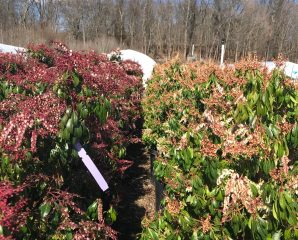We love Japanese Andromeda, and ‘Dorothy Wykoff’ (left) and ‘Scarlet O’Hara’ (right) are at the top of our list! Pieris japonica is a shade loving, deer resistant evergreen with distinctive buds, flowers and foliage. It is one of the most widely used plants in the landscape. They’re a staple for shadier sites including the north side of buildings, as an evergreen shrub for under larger shade trees, in the mixed border, along the foundation etc. Our smaller containers offer an evergreen choice for your winter containers and the larger sizes (#15 seen here) make a substantial addition to any established landscape. As a slow grower there is not a lot of maintenance other than trimming back the dried flower capsules after flowering, if desired. They grow approximately 10′ high x 6′ wide if not trimmed. They are happiest in partial to full shade in moist, well-drained soil. As a year-round plant they are A+!
Spring – Strands of small, long lasting flower panicles open from their winter buds in early spring. The glossy, new leaves are striking. ‘Scarlet O’Hara’s’ are white flowers opening from light pink buds and ‘Dorothy Wykoff’ has deep red buds opening to pale pink flowers. The new emerging red foliage contrasts nicely with the older green leaves making it a stellar team.
Summer – The new growth is still noticeable early summer, then will turn glossy green. The flower buds will start to form. The evergreen leaves make a nice backdrop to other flowering shrubs and perennials.
Fall – The strands of lacy flower buds are the highlight now, especially ‘Dorothy Wykoff’s’ which are wine-red. When the temperatures drop her evergreen leaves begin to color up from green to burgundy red.
Winter – The foliage looks great as a backdrop for the flower buds which are beginning to swell before they bloom, and the bronze or red new growth begins slowly to emerge.
Some other varieties in stock include ‘Compacta’ (dense habit with smaller leaves), ‘Flaming Silver’ (variegated leaves with pink to white margins), and ‘Mountain Fire’ (bright, orangey-red new growth in spring).

